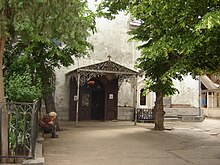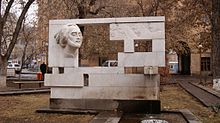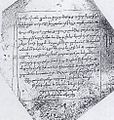Sayat-Nova
Sayat-Nova Սայաթ-Նովա | |
|---|---|
 Oil on canvas portrait of Sayat-Nova byEduard Isabekyan(1964). | |
| Born | Harutyun Sayatyan 14 June 1712 Tiflis,Kingdom of Kartli,Safavid Iran(present-day Georgia) |
| Died | 22 September 1795(aged 83) Haghpat,Kingdom of Kartli-Kakheti,Qajar Iran(present-day Armenia) |
| Occupation | Poet,ashugh |
| Nationality | Armenian |
| Spouse | Marmar Shahverdian |

Sayat-Nova(Armenian:Սայեաթ-Նովայ(сlassical),Սայաթ-Նովա(reformed);Georgian:საიათნოვა;Azerbaijani:سایاتنووا;Persian:سایاتنووا;bornHarutyun Sayatyan;14 June 1712 – 22 September 1795) was anArmenianpoet,musicianandashugh,who had compositions in a number of languages.
Name
[edit]The name Sayat-Nova has been given several interpretations.[1]One version reads the name as "Lord of Song" (from Arabicsayyidand Persiannava)[1]or "King of Songs".[2][3]Others read the name as grandson (Persianneve) of Sayad or hunter (sayyad) of song.[1]Charles Dowsett considers all these derivations to be unlikely and proposes the reading New Time (from Arabicsa'atand Russiannova) instead.[1]
Biography
[edit]This sectionneeds additional citations forverification.(April 2013) |
Sayat-Nova's mother, Sara, was born inTiflis,and his father, Karapet, either inAleppoorAdana.He was born in Tiflis. Sayat-Nova was skilled in writing poetry, singing, and playing thekamancheh,Chonguri,Tambur.[4]He lost his position at the royal court when he fell in love with the king's sister Ana; he spent the rest of his life as an itinerant bard.
In 1759 he was ordained as a priest in theArmenian Apostolic Church.His wife, Marmar, died in 1768, leaving behind four children. He served in locations including Tiflis andHaghpat Monastery.In 1795 he was killed in Haghpat Monastery by the invading army ofAgha Mohammad Khan Qajar,the Shah of Iran. Agha Mohammad Khan demanded that Sayat Nova convert fromChristianitytoIslam[dubious–discuss],which he refused to do, and declaring his religion is undeniablyArmenian Christian.Hence he was promptly executed by beheading.[5]He is buried at the ArmenianCathedral of Saint GeorgeinTbilisi.
Legacy
[edit]
In Armenia, Sayat-Nova is considered a great poet who made a considerable contribution to the Armenian poetry and music of his century. Although he lived his entire life in a deeply religious society, his works are mostly secular and full ofromanticexpressionism.
About 220 songs have been attributed to Sayat-Nova, although he may have written thousands more. Sayat-Nova also wrote some poems moving between all three.[clarification needed]
In popular culture
[edit]
- Sayat Nova Dance Company of Bostonis named after him.
- The 1969 Armenian filmSayat Novadirected bySergei Parajanovfollows the poet's path from his childhoodwool-dyeing days to his role as a courtier and finally his life as amonk.It was released in the United States under the titleThe Color of Pomegranates.It is not a biography of Sayat Nova, but a series oftableaux vivantsof Armenian costume, embroidery and religious rituals depicting scenes and verses from the poet's life.
- A book on his life and work byCharles Dowsettwas published in 1997 titledSayat'-nova: An 18th-century Troubadour: a Biographical and Literary Study.
- The first translations of the Armenian odes of Sayat Nova in European languages were inRussiabyValery Bryusovin 1916, inGeorgiabyIoseb Grishashviliin 1918, inPolandbyLeopold Lewinin 1961 and inFranceby Elisabeth Mouradian and the French poetSerge Venturiniin 2006; the book was dedicated toSergei Parajanov.
- There is a street anda music schoolnamed after him inYerevan,Armenia; anArmenian-Americandance ensemble in the United States; and a pond inMont Orford,Quebec, Canada.
- A brand of Armenian Cognac is named after him.[6]
- An Armenian restaurant opened inChicago'sStreetervilleneighborhood in 1970 is named after him.[7]
- In 2020, a perfume created by Dmitry Bortnikoff and Rajesh Balkrishnan was named after him.
- The piano piece "Elegy in Memory ofAram Khachaturian"byArno Babajanianis based on a melody by Sayat-Nova.
Gallery
[edit]-
An Armenian-Georgian poem written by Sayat-Nova using mix of Armenian and Georgian alphabets.
-
A poem written inAzeriusing Georgian letters.
References
[edit]- ^abcdCharles Dowsett (1997).Sayatʻ-Nova: An 18th-century Troubadour: a Biographical and Literary Study.Peeters Publishers. pp. 70–73.ISBN9789068317954.
- ^Thomas de Waal."The Caucasus: An Introduction"Oxford University Press,2010ISBN978-0199750436p 25
- ^Jennifer G. Wollock."Rethinking Chivalry and Courtly Love"ABC-CLIO, 2011.ISBN978-0313038501p 246
- ^Dowsett, Charles(1997), p. 4
- ^Dowsett, Charles(1997).Sayatʻ-Nova: an 18th-century troubadour: a biographical and literary study.Leuven:Peeters Publishers.p. 362.ISBN90-6831-795-4.
- ^"SAYAT NOVA Trademark of" MALS "LLC Serial Number: 79092017:: Trademarkia Trademarks".
- ^"Sayat Nova".Check, Please! | WTTW Chicago.30 July 2012.Retrieved16 April2022.
Sources
[edit]- Charles Dowsett,(1997),Sayatʻ-Nova: an 18th-century troubadour: a biographical and literary study,ISBN90-6831-795-4
- Nikoghos Tahmizian,Sayat Nova and the Music of Armenian Troubadours and Minstrels,(in Armenian), 1995, Drazark Press, Pasadena, Ca.
External links
[edit]- Site dedicated to Sayat-Nova
- Armenianmusicarch.com
- Love Songtranslated into English by Alice Stone Blackwell
- Classical Composers Database
- Encyclopædia Britannica
- Sayat-Nova's Armenian, Georgian, Tatarian songs and their Russian translations in digital works collection with famous performances of poems and songs


